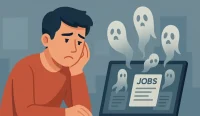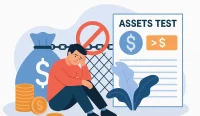Increasing number of Americans feel ‘stuck’ at work – this is the hidden crisis unfolding in the American labor market that’s not reflected in the headline unemployment numbers. Despite unemployment rates remaining at a relatively low 4.3%, a new report from the Wall Street Journal reveals a disturbing trend: qualified professionals with advanced degrees are struggling to find stable, full-time employment, forcing them to take part-time work or jobs completely outside their field.
The reality is that while people can get jobs, they’re not comparable to the ones they left. Many aren’t even full-time positions. This creates a perfect storm where highly educated individuals with PhDs in academia and advanced degrees in tech are working at sandwich shops or as part-time nannies because they can’t find anything else. They’ve been applying for hundreds of jobs for months without even getting a response, creating a deeply discouraging situation for people who want to work and have excellent backgrounds.
The U-6 Rate: The Real Story Behind the Numbers
The headline unemployment rate of 4.3% tells only part of the story. The U-6 rate, which measures discouraged workers and those in part-time jobs who would prefer full-time work, is at its highest level in nearly four years. This broader measure of labor market health shows that people on the margins of the labor market are really starting to struggle.
The U-6 rate has been creeping up over the past two years, reaching this nearly four-year high. This is a clear sign that there are a lot of people out there who are not able to get into the jobs they want, and they’re really taking anything they can get. The situation is particularly dire for those with advanced credentials who find themselves working in service sector jobs or other positions completely outside their field of expertise.
The Gradual Cooling: Signs of Labor Market Strain
The labor market has really slowed over the past year, with much slower job creation in recent months. Initial jobless claims have risen to their highest level since October 2021, creating a gradual drip, drip, drip of things starting to feel more difficult for people who are looking for work.
This cooling trend is affecting people across all education levels and industries. The Wall Street Journal’s economics correspondent, Harriet, reported that her inbox was full of readers saying they’re having the same problem: they had a great job, but it’s been ten or twelve months, and they really haven’t been able to find anything else. It’s just hard.
The pandemic created a surge in remote jobs, but at this point, people seem to be really struggling to get them. These positions are so coveted because you could stay in your hometown and might not necessarily have to move to a different city for work. However, there are so many applications that people are sending out thousands of applications and getting rejection emails within 20 minutes because they’re being filtered out by some system.
The AI Filter Problem: When Technology Becomes a Barrier
One of the most frustrating aspects of the current job market is the way technology is being used to filter applications. Job seekers complain that they feel like jobs are being advertised that maybe don’t exist, and they’re getting filtered out by AI systems before a human ever sees their application.
The people who are actually working tend to say that the reason they got their job was because somebody who lives near them, somebody in their social circle, or just walking from place to place and striking up a conversation is the way they’ve been getting actual interviews. This suggests that personal connections are becoming more important than ever, while online applications are becoming less effective.
The labor market is changing in many ways, and job seekers are finding that traditional application methods are no longer working. They’re sending out hundreds or even thousands of applications without getting responses, leading to a sense of discouragement and frustration that’s difficult to overcome.
The Service Sector Fallback: When Education Doesn’t Match Employment
The most visible sign of this crisis is the number of highly educated individuals who are forced to take service sector jobs or other positions completely outside their field. People with PhDs in academia and great undergraduate degrees in tech are working at sandwich shops or as part-time nannies because they really can’t find anything else.
This creates a mismatch between education and employment that’s both economically inefficient and personally devastating. These individuals have invested years in their education and training, only to find themselves in positions that don’t utilize their skills or provide the financial stability they need.
The situation is particularly difficult for those who have been out of work for extended periods. After months or even years of searching, they’re taking whatever they can get, even if it means working in a completely different field or accepting part-time work that doesn’t provide the benefits or security they need.
The Remote Work Paradox: High Demand, Low Availability
Remote work has become one of the most sought-after benefits in the current job market, but it’s also one of the most difficult to obtain. The pandemic created a surge in remote positions, but the demand far exceeds the supply, creating intense competition for these coveted positions.
People are applying for remote jobs in droves, but the competition is so fierce that many qualified candidates are being filtered out before they even get a chance to interview. This creates a situation where people are stuck in their current locations, unable to find work that matches their skills and experience.
The remote work paradox highlights a fundamental mismatch between what workers want and what employers are offering. While many companies have embraced remote work, others are pulling back, creating uncertainty and frustration for job seekers who are specifically looking for these positions.
The Remote Work Paradox
Remote work is in high demand but short supply, creating fierce competition for limited opportunities. Employers who embrace flexibility stand out and attract top talent seeking balance and freedom. Post your job on WhatJobs today and highlight your remote or hybrid opportunities to connect with the best candidates.
Post a Job Free for 30 Days →The Economic Policy Implications: What This Means for the Fed
This trend of Americans feeling stuck at work has important implications for economic policy decisions, particularly those made by the Federal Reserve. The gradual cooling of the labor market, combined with rising jobless claims and the U-6 rate reaching a four-year high, suggests that there’s more strain in the labor market than the headline numbers indicate.
Economists are watching these trends closely, as they could influence future interest rate decisions and other monetary policy measures. While the unemployment rate remains relatively low, the underlying data suggests that the labor market is not as healthy as it might appear on the surface.
The Fed’s decisions are based on a variety of economic indicators, and the growing number of Americans who feel stuck in their current jobs or are unable to find suitable employment could be a factor in future policy decisions. This is particularly important as the economy continues to recover from the pandemic and faces new challenges.
The Personal Impact: Stories from the Front Lines
The personal impact of this crisis is devastating for individuals and families. People who have worked hard to build their careers and develop their skills are finding themselves in positions that don’t match their qualifications or provide the financial stability they need.
The emotional toll is significant, as people struggle with feelings of inadequacy and frustration. They’ve done everything “right” – gotten an education, gained experience, built networks – but they’re still unable to find work that matches their skills and provides the security they need.
This situation is particularly difficult for those who have been out of work for extended periods. The longer someone is unemployed, the more difficult it becomes to find work, creating a cycle that’s difficult to break. Many people are taking whatever work they can find, even if it means accepting positions that are far below their skill level or in completely different fields.
Strategies for Navigating the Stuck-at-Work Crisis
Despite the challenges, there are strategies that can help people navigate this difficult job market:
• Focus on networking – Personal connections are more important than ever
• Consider alternative paths – Look for opportunities in related fields or industries
• Develop new skills – Stay current with industry trends and technologies
• Be flexible about location – Consider opportunities in different geographic areas
• Think creatively – Look for ways to apply your skills in new contexts
The key is to remain adaptable and open to opportunities that might not follow traditional career paths. While the current job market is challenging, there are still opportunities for those who are willing to think creatively and put in the effort to find them.
The Long-Term Outlook: What This Means for the Future
The current situation suggests that the labor market is undergoing fundamental changes that could have long-term implications for workers and employers alike. The mismatch between education and employment, combined with the increasing use of AI in hiring processes, suggests that traditional career paths may no longer be as reliable as they once were.
This could lead to a more fluid job market where people need to be more adaptable and willing to change careers multiple times throughout their working lives. It also suggests that the relationship between education and employment may need to be rethought, as traditional degrees may no longer guarantee access to suitable employment.
The long-term implications are significant, as this trend could affect everything from education policy to retirement planning. Workers may need to be more proactive about managing their careers and developing skills that are in demand, rather than relying on traditional educational credentials.
Frequently Asked Questions
Why are an increasing number of Americans feeling stuck at work?
An increasing number of Americans feel ‘stuck’ at work because while unemployment rates remain low, the U-6 rate (measuring discouraged workers and part-time workers who want full-time jobs) is at a four-year high, forcing qualified professionals to take jobs below their skill level.
What is the U-6 unemployment rate and why is it important?
The U-6 unemployment rate measures discouraged workers and those in part-time jobs who would prefer full-time work, providing a broader view of labor market health than the headline unemployment rate, and it’s currently at its highest level in nearly four years.
How is AI affecting job applications and hiring?
AI is filtering out many qualified candidates before human reviewers see their applications, with job seekers receiving rejection emails within 20 minutes of applying, making personal connections and networking more important than ever.
Why are highly educated people working in service sector jobs?
Highly educated people are working in service sector jobs because they can’t find employment in their fields despite applying for hundreds of jobs for months, forcing them to take whatever work is available to make ends meet.
What role does remote work play in the current job market?
Remote work has become highly coveted but extremely competitive, with far more applicants than available positions, leading to intense competition and many qualified candidates being filtered out before interviews.
A Real-World Example: Maria’s Journey Through the Stuck-at-Work Crisis
Maria, a 32-year-old marketing professional with an MBA and 8 years of experience, found herself in the exact situation described in the Wall Street Journal report. After her company downsized during the pandemic, she spent 14 months applying for marketing positions, sending out over 500 applications.
“I was getting rejection emails within minutes of applying,” Maria explains. “It felt like my applications weren’t even being seen by human eyes. I had all the right qualifications, but I couldn’t get past the AI filters.”
After months of frustration, Maria started working as a part-time nanny to make ends meet. “It was humbling to go from managing million-dollar marketing campaigns to changing diapers, but I needed to pay my bills,” she says.
Maria’s breakthrough came when she started attending local business networking events. “I met someone who worked at a startup that was looking for marketing help, but they weren’t advertising the position online,” she explains. “They hired me as a consultant, and that led to a full-time position.”
Maria’s story illustrates how the current job market requires a different approach than traditional online applications. “Personal connections are everything now,” she says. “The people who are getting jobs are the ones who are networking and building relationships, not just sending out applications.”
Don’t Let the Market Define Your Worth
The current job market crisis is real and affecting millions of Americans, but it doesn’t define your worth or your potential. While the statistics are discouraging, there are still opportunities for those who are willing to adapt and think creatively about their career paths.
The key is to focus on what you can control: building relationships, developing new skills, and staying open to opportunities that might not follow traditional paths. The job market may be challenging, but your determination and adaptability can help you navigate through it.




